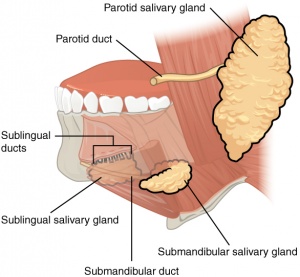Dry Mouth: Difference between revisions
Wendy Walker (talk | contribs) No edit summary |
Wendy Walker (talk | contribs) No edit summary |
||
| Line 18: | Line 18: | ||
== Anatomy<br> == | == Anatomy<br> == | ||
[[Image:2408_Salivary_Glands.jpg|left|300px]] | |||
This image shows the 3 main salivary glands. | |||
The Sublingual and Submandibular glands are supplied by the Facial Nerve (7th Cranial Nerve); the Parotid gland is supplied by the Glossopharyngeal Nerve (9th Cranial Nerve). | |||
In addition to these 3, there are more than 800 minor salivary glands spread out throughout the oral mucosa. These minor gsalivary glands are supplied by the Facial Nerve. | |||
auses<br> | |||
== Advice == | == Advice == | ||
== Resources<br> | == Resources<br> == | ||
Revision as of 22:53, 15 November 2015
Original Editor - Your name will be added here if you created the original content for this page.
Lead Editors - Wendy Walker and Tarina van der Stockt
Signs & Symptoms[edit | edit source]
- sensation of dryness/stickiness in the mouth
- burning sensation in the mouth
- tongue “sticking” causing difficulty in speaking
- difficulty moving food in mouth when eating, especially dry food such as bread
- increased sores/mouth ulcers
Anatomy
[edit | edit source]
This image shows the 3 main salivary glands.
The Sublingual and Submandibular glands are supplied by the Facial Nerve (7th Cranial Nerve); the Parotid gland is supplied by the Glossopharyngeal Nerve (9th Cranial Nerve).
In addition to these 3, there are more than 800 minor salivary glands spread out throughout the oral mucosa. These minor gsalivary glands are supplied by the Facial Nerve.
auses







